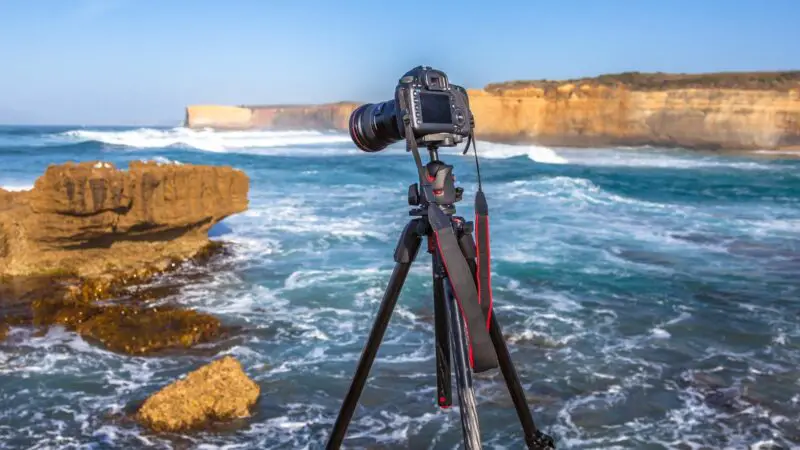Choosing the right lens for Canon DSLR cameras can be confusing. Aside from Canon lenses, there are also some third-party lenses, such as Sigma and Tamron. Their prices are also very competitive. Yet, it depends on what you need. Are you into wildlife, sports, travel, landscapes, macro (extreme close-up), or portrait photography?
Note also that there are two types of Canon lenses – the EF mount and the RF mount. The former is for DSLRs, while the latter is for mirrorless cameras, which are completely different. In most cases, they are not interchangeable. To help you decide, below are some of the best lenses for Canon DSLRs in different types of photography.
Table of Content
Travel and Landscape Photography

1. Canon EF 70-300mm f/4-5.6 IS II USM
- Versatile Telephoto Zoom: The Canon EF 70-300mm f/4-5.6 IS II USM Lens offers a flexible zoom range, ideal for various subjects from portraits to wildlife, making it a great all-around lens.
- Advanced NANO USM Technology: Combines a fast Ultrasonic Motor (USM) for still photography with a smooth, silent Stepping Motor (STM) for video, delivering quick and precise autofocus for multimedia creators.
- Effective Image Stabilization: The lens features an Image Stabilizer that compensates for up to four stops of camera shake, ensuring sharper handheld shots even at slower shutter speeds.
This was introduced in September 2016. The Canon EF 70-300mm f/4-5.6 IS II USM is a budget-friendly telephoto zoom lens designed for APS-C and full-frame Canon EF-mount DSLRs. It is ideal for landscape photography. This mid-level lens has many improvements compared to its discontinued predecessor, the EF 70-300mm f/4-5.6 IS USM.
First, the EF 70-300mm f/4-5.6 IS II USM is the second Canon lens to feature Nano USM technology, next to the EF-S 18-135mm f/3.5-5.6 IS USM. This system uses a ring-type USM (Ultrasonic Motor) and a screw-type STM (Stepper Motor) mechanism. This is to provide super-fast autofocusing (AF) and nearly quiet photo and video shoots.
The EF 70-300mm f/4-5.6 IS II USM is also the first Canon lens to feature an LCD Information Display located on the top of the lens barrel. Like the earlier 70-300mm lens, this quiet lens has 4-stop image stabilization for sharper handheld shooting during difficult lighting conditions. Yet, it has 9 rounded diaphragm blades.
It weighs only 710 grams and measures 80 × 146 mm (3.14 x 5.74 inches). This second EF 70-300mm f/4-5.6 IS has a filter diameter of 67 mm, a minimum focusing distance of 1.2 meters, and a maximum magnification of 0.25x. The only concern here is that this lens is not weather-sealed. Other than that, it could be the best telephoto zoom lens.
2. Tamron 10-24mm f/3.5-4.5 Di II VC HLD
- VC (Vibration Compensation)
- HLD (High/Low torque-modulated Drive)
- Moisture-resistant construction
Announced in February 2017, the Tamron 10-24mm f/3.5-4.5 Di II VC HLD is an ultra-wide-angle zoom lens for Canon APS-C DLSRs such as the Canon EOS 8D. It is best suited for landscape photography. This discontinued consumer-grade lens is nearly completely redesigning its predecessor, the Tamron 10-24mm f/3.5-4.5 Di II LD SP AF.
Like the f/3.5-4.5 Di II LD SP AF, the f/3.5-4.5 Di II VC HLD also has a 77-mm ultraviolet filter, an iris diaphragm with 7 circular aperture blades, and a maximum magnification of 0.19x. It also consists of 16 elements in 11 groups instead of only 12 elements in 9 groups. But as expected, this newer 10-24mm f/3.5-4.5 Di II is a bit bigger and heavier.
The 10-24mm f/3.5-4.5 Di II has now the newly-developed HLD (High/Low Torque Modulated Drive Motor) AF system for exceptional power and stability, a VC (Vibration Compensation) mechanism to reduce camera shake, and 4-stop image stabilization. It also has extra-low dispersion (XLD) and low dispersion (LD) elements.
For less vulnerability against damage and dirt and easier maintenance, this user-friendly lens is coated with a water and oil-repellent fluorine compound, rubberized focus, and zoom rings. There is minimal distortion, though, and no lens corrections option exists. But overall, this 10-24mm f/3.5-4.5 Di II VC HLD is a true gem at under $500.
3. Canon EF 24-105mm f/4L IS II USM
- All-new optical design with significant improvements in peripheral brightness.
- High-performance standard zoom lens with constant f/4L aperture and a broad angle of view covering from wide angle to mid-telephoto.
- Air Sphere Coating (ASC) helps to significantly reduce flare and ghosting. Diagonal Angle of View:84°00' - 23° 20'
It was released in August 2016. The Canon EF 24-105mm f/4L IS II USM is a professional standard zoom lens designed for Canon’s full-frame and APS-C DSLR cameras. This second EF 24-105mm f/4L IS USM has more compelling features than its predecessor, making it great for travel and landscape photography. Fortunately, the price is also a bit lower.
The first and second EF 24-105mm f/4L are weather-sealed, have the same viewing angles, a 77-mm filter thread, and a minimum focusing distance of 0.45 m (1.47 ft). However, the newer version has an image stabilizer at up to 4 stops instead of 3. The number of rounded diaphragm blades has also been increased from 8 to 10.
The EF 24-105mm f/4L IS II USM has 17 elements in 12 groups, including Air Sphere Coating (ASC), to reduce flare and ghosting. The front and rear elements are coated with grease and water-repellent fluorine, which makes the lens easier to clean. Unlike its predecessor, the maximum magnification slightly increases at 0.24x from 0.23x.
This upgraded lens also has a zoom lock switch. It disables the lens from zooming past the 24mm setting when used. This unwanted zooming usually happens when the camera is pointed down, especially for heavy users. With all its innovative features, this versatile and faster EF 24-105mm f/4L IS II USM is a home run.
4. Canon EF 16-35mm f/2.8L III
- High performance L-series ultra-wide-angle zoom lens with constant f/2.8 maximum aperture.
- All-new optical design for significant improvements in outer and corner sharpness.
- Sub wave length Coating (SWC) and Air Sphere Coating (ASC) help to significantly reduce flare and ghosting.
One of Canon’s top wide-angle zoom L series lenses is the EF 16-35mm f/2.8L III USM lens. To completely correct for typical optical flaws, such as field distortion, it has a 16-element lens. Together with this, it has a very fast fixed f/2.8 aperture making it perfectly suited to landscape photographers.
Particularly when used wide open at 16mm, the upgraded version of the lens is noticeably sharper than its predecessor. When shooting wide open, the lens’s central sharpness is quite excellent. You won’t feel diffraction’s impacts until F5.6 at 16mm.
You might detect light loss in the corners when using a 16mm focal length with an f/2.8 lens. Although stopping down helps, you must use an f-stop of f/8 or smaller to eliminate this phenomenon. With the wide-angle 16mm focal length, barrel distortion is noticeable; it vanishes at 24mm.
The 16-35mm coverage range is wide-angle with a full-frame camera. Large, expansive landscapes and group photos are all possible. You can get near subjects since it can focus close to 11 inches from the sensor location.
Portrait and Outdoor Photography

1. Canon EF 24–70mm f/4L IS USM
- L‐Seriesstandardzoomlensdeliverssuperbimagequalityinacompact,lightweightdesign
- 2 aspheric and 2 UD lens elements for high image quality throughout the entire zoom range
- Fullmacroshootingmodewithupto0.7xmagnification,easilyaccessiblewithaone‐touch switch at the extreme telephoto end
Announced in November 2012, the Canon EF 24-70mm f/4L IS USM is a wide-to-short telephoto zoom lens suited for landscape and portrait photography. This professional standard lens is the third member of the EF 24-70mm L family. It is smaller and lighter than EF 24–70mm f/2.8L II and is compatible with full-frame and APS-C DSLRs.
Like its older EF 24-70mm f/2.8L siblings, the EF 24-70mm f/4L IS USM is weather-sealed, with the same f/22 minimum aperture and a minimum focus distance of 0.38 m. (14.9 inches), and ultrasonic motor. Despite being the cheapest among the three, this impressive lens is the only one with hybrid image stabilization (4 stops) and “macro” mode.
Although not considered a true macro lens, this f/4 version has a switch-activated macro mode with a maximum magnification of 0.7x. It is built around 15 elements in 16 groups and equipped with a 9-blade circular diaphragm to deliver softer and more beautiful images. Like the first 24-70mm f/2.8L, this lens has a 77-mm filter thread.
However, the EF 24-70mm f/4L IS USM may have some distortion at 24 mm, but it will completely disappear at 35 mm. But overall, this high-performer produces quality images. Sadly, Canon has discontinued this model since March 2021 with no replacement yet. But don’t worry; some stocks are still online now under $500.
2. Canon EF 85mm f/1.4L IS USM
- Canon’s First 85mm L-series Lens with IS Capability.
- Large, Bright f/1.4 Aperture.
- Image Stabilization at up to 4* Stops of Shake Correction.
Released in August 2017, the Canon EF 85mm f/1.4L IS USM is the fourth (and would probably be the last) member of the EF 85mm family. Despite having one-third of a stop apart from its f/1.2 siblings, this younger lens can produce sharp handheld images in extremely low light conditions, making it ideal for portrait and outdoor photography.
Like the EF 85mm f/1.8 USM, the EF 85mm f/1.4L IS USM has a minimum aperture of f/22 and a minimum focusing distance of 0.85 m. (2.78 ft) and a maximum magnification of 0.13x. But unlike its siblings, it has 14 elements in 10 groups and is equipped with a wider 77-mm filter thread and nine rounded diaphragm blades instead of only eight.
Furthermore, the elements of professional L lenses, such as the EF f/1.2L and EF 85mm f/1.4L, were constructed using Air Sphere Coating (ASC) technology combined with updated Super Spectra Coatings (SSC). This means that backlit flaring and ghosting are greatly reduced. It allows more light to enter the lens to produce cleaner images.
But most importantly, the EF 85mm f/1.4L IS USM is equipped with a 4-stop optical image stabilizer. It consistently helps in minimizing camera shake. This results in sharper handheld shooting under dull ambient lighting. It is also smaller and lighter than the two f/1.2L USM models. But because it is an L series, the price is quite high.
3. Sigma 85mm f/1.4 DG HSM Art
- The Sigma 85mm 1.4 DG HSM Art is the latest addition to the world renowned Sigma Global Vision Line
- It has equipped newly designed hyper sonic motor (HSM) for nimble AF control, 1.3 times better torque of its predecessor
- This lens is compatible with Mount converter MC-11 , so Sony E-mount users can also enjoy this lens with it
Announced in September 2016, the Sigma 85mm f/1.4 DG HSM Art is an upgraded version of the 2010 Sigma 85mm f/1.4 EX DG HSM. Aimed at professional portrait photographers, this redesigned prime lens has impressive features and can produce gorgeous and excellent images. It also works well with Canon EF cameras.
Like its predecessor, the Sigma 85mm f/1.4 DG Art lens offers a minimum focus distance of 0.85m and a maximum magnification of 0.12x. It is also equipped with a ring-type HSM (Hyper Sonic Motor) but with 1.3x the 85mm F1.4 EX DG HSM torque. This updated AF system allows faster, quieter, and more efficient autofocusing.
Like the Canon EF 85mm f/1.4L IS USM, the Sigma 85mm f/1.4 DG lens has a closest focusing distance of 0.85 m. (2.78 ft) and 9 rounded diaphragm blades. However, this Sigma lens has no image stabilizer, which can be challenging in fast-action shooting. Still, the 14 elements (in 12 groups) have a long and complex optical path.
Despite being bulky and heavy at 1,131 grams (around 2.5 lbs.), the Sigma 85mm f/1.4 DG HSM Art won as the Best DSLR Prime Lens during the 2017 TIPA Awards. Meanwhile, Sigma declared Art lenses as weather-resistant (dust and splashproof) instead of weather-sealed. This lens is also a bit pricey but worth the price.
4. Canon EF 50mm f/1.8 STM
- 50 millimeter focal length and maximum aperture of f/1.8
- Great for portraits, action, and nighttime photography; Angle of view (horizontal, vertical, diagonal): 40º, 27º,46º
- Minimum focusing distance of 1.15 feet (0.35 meter) and a maximum magnification of 0.21x
The EF 50mm f/1.8 quickly gained a solid reputation as a remarkably small and reasonably priced fixed-focal-length standard lens. This lens is quite adaptable for a full-frame camera since it has a long focal length to blur backgrounds and a reasonable distance that allows subjects to be captured without perspective distortion.
This lens has an extremely wide aperture. Wider apertures enable shutter speeds in low light because they increase the amount of light that reaches the imaging sensor. Wider apertures also result in a shallower depth of field (DOF), which makes it possible to produce a significant background blur.
Images taken with the lens closed down to f/2.8 appear noticeably softer than those taken with it fully open at f/1.8. Users shouldn’t neglect using the lens at f/1.8 with the aperture fully open to produce an extremely small depth of focus. Simply put, reducing the lens down one or two stops improves center and edge sharpness. The perfect aperture range is between f/8 and f/11 for the clearest possible images.
Macro Photography

1. Canon EF 100mm f/2.8L Macro IS USM
- 100 millimeter focal length and 1:2.8 maximum aperture. The EF1.4X II; EF2X II extenders cannot be used with this lens. There are no compatible close-up lenses
- Lens construction consists of 15 elements in 12 groups
- 23.4-Degree diagonal angle of view
Launched in September 2009, the Canon EF 100mm f/2.8L Macro IS USM replaced the non-L EF 100mm f/2.8 Macro USM. Since this newer version has an “L” in its name, it has many major upgrades compared to its discontinued predecessor. As a true macro lens for extreme close-up photography, it provides a very shallow depth-of-field of 1:1.
The best improvement in this EF 100mm f/2.8L Macro lens is adding the hybrid image stabilization unit, which offers 4 stops. As you most likely know, macro photography usually requires a tripod. But since there are instances where using a tripod is impossible, this is when the image stabilizer comes to the rescue.
This is the only L model in the EF 100mm model series. It has the least minimum focusing distance of 302 mm (11.8 inches). Also, it has the largest filter diameter at 67 mm, the smallest diagonal view angle at 23.4°, and nine diaphragm blades. This sturdy macro lens weighs 625 grams and is the longest at 122 mm.
The EF 100mm f/2.8L Macro IS USM comprises 15 elements in 12 groups, including an ultra-low dispersion (UD) glass element. But since the image stabilizer may not be always effective, the lens has a tripod foot and an optional accessory, the Canon Tripod Mount Ring D. Despite the age and high price, this lens is still worth the buy.
2. Sigma 70mm F2.8 Art DG Macro
- Focal length: 70mm
- Aperture range: f/2.8 - f/22
- Canon EF mount lens
It was released in February 2018. The Sigma 70mm F2.8 Art DG Macro is the company’s first macro lens in their Art-series models. Compatible with Canon EF cameras, this Sigma 70 mm f/2.8 EX DG Macro successor is a true macro lens with 1:1 macro magnification. Despite having no optical image stabilization, it has powerful features for macro shots.
The Sigma 70mm F2.8 Art DG Macro has a fast and relatively quiet coreless DC AF motor. It is constructed with 13 lens elements in 10 groups, including 2 aspherical elements, 2 FLD glass elements, and 2 SLD glass elements. Like many E-mount lenses, this Sigma macro lens has a smooth focus-by-wire system for precise focusing.
Additionally, it is equipped with 9 rounded diaphragm blades and a 49-mm filter thread. This Sigma 70mm lens has a solid focus limiter to help you focus on a specific distance. It allows a minimum focus distance of 0.26 m and an f/22 minimum aperture. Weighing 515 grams and 106 mm long, this lens is compatible with Canon Lens Aberration Correction.
This is not advertised as weather-resistant. It has a dependable rubber seal around the mount to prevent dust and water splashes from entering. AF is a bit slower than average, though. Yet, the image quality is excellent. Overall performance is also flawless. Indeed, it is a highly-recommended budget-friendly lens.
3. Tamron 90mm f/2.8 Di VC USD Macro F017
- advanced coating technology improves lens performance
- Minimum Focus Distance : 0.3m (11.8 in), Focal Length : 90 mm
- Moisture-resistant construction helps prevent moisture from penetrating the lens
The Tamron 90mm f/2.8 Di VC USD Macro F017 lens was released in August 2016. But it is still one of the best macro lenses for Sony A, Nikon F, and Canon EF cameras. Despite being phased out, this gem is still available online. It has a true 1x maximum magnification and undeniably excellent features as a third-party alternative to Canon macro lens.
As a popular macro lens, the Tamron 90mm f/2.8 Di VC USD Macro F017 comprises 14 elements in 11 groups, including two extra-low dispersion (ED) glass elements and one low-dispersion (LD) glass element. It also comes with 3.5-stop optical image stabilization and USD (Ultrasonic Silent Drive) that allows nearly-silent auto-focusing.
This last 90mm f/2.8 Macro lens is also equipped with a new and improved ‘XY-Shift’ optical stabilizer with an accelerometer to compensate for the camera shake and vibration. This is equivalent to Canon’s hybrid stabilizer. Hence, you may no longer need a tripod. This F017 model also has a minimum focus distance of 30 cm (11.8 inches).
The 9 rounded iris diaphragm blades produce a beautiful bokeh (out-of-focus area effect). However, some visible outlines could be at the bokeh edges, especially at macro distances. This macro lens is coated with eBAND and BBAR layers to combat ghosting and flare. In short, this lightweight Tamron 90mm F017 is worth buying.
Wildlife and Sports Photography

1. Canon EF 600mm f/4L IS III USM
- Revised Optics for a lighter Super telephoto EF L Lens
- Continues strong tradition of image quality associated with L-Series lenses
- Super spectra coating (ssc) and Air sphere coating (asc) minimizes ghosting and flare
It was released in September 2018. The Canon EF 600mm f/4L IS III USM is a professional-grade lens that can be your ultimate choice for wildlife and field sports photography. This incredible lens is $1,000 more expensive than its 2011 predecessor, the EF 600mm f/4L IS II USM, but is surely very satisfying considering its capabilities.
At first glance, the EF 600mm f/4L IS III looks similar to the second one. They are 448 mm (17.6 inches) long and have a maximum diameter of 168 mm (6.6 inches). Yet, this third 600mm f/4L IS USM is 870 grams lighter at 3050 grams (6.72 lbs). This superb prime lens is the lightest among the Canon EF 600mm lens model series.
The major upgrades of the EF 600mm f/4L IS III include having the shortest closest focusing distance at 4.2 m (13.78 ft) and image stabilization at up to 5 stops. Like its predecessor, this third 600mm f/4L uses 9 rounded diaphragm blades and offers a 0.15x maximum magnification. This means that they are not designed for macro shots.
The EF 600mm f/4L IS III is built around 17 elements in 13 groups. It includes one super UD (ultra-low dispersion) element, Air Sphere Coating (ASC), Super Spectra Coating (SSC), and two fluorite elements. Without a doubt, this top-notch lens is a beast in terms of performance and results. But of course, you should be willing to pay the price.
2. Canon EF 100-400mm f/4.5-5.6L IS II USM
- Compact, high performance L-series super-telephoto zoom makes it ideal for sports and wildlife photography
- Rotation-type zoom ring allows for more precise composition and excellent balance when handholding.Rounded 9-Blade Diaphragm
- Improved zoom torque adjustment ring allows easy setting of zoom tension, Focal Length & Maximum Aperture:100-400 millimeter 1:4.5-5.6, Closest Focusing Distance-3.2 feet; 0.98 meter
It was released in November 2014. The Canon EF 100-400mm f/4.5-5.6L IS II USM is a popular professional-grade lens for wildlife photography and is ideal for outdoor sports. This 100-400mm Mark II zoom lens replaced the classic f/4.5-5.6L IS USM to add some superior features. It is also now around $500 cheaper than its initial price.
Like the original version, the EF 100-400mm f/4.5-5.6L IS II also has an image stabilizer but at a higher 4 stops instead of 2. Both of them have a minimum aperture of f32–40. However, the 2014 version has a minimum focus distance of 0.98 m instead of 1.8 m. The 100-400mm Mark II also has a higher maximum magnification from 0.20x to 0.31x.
It was built with 21 elements in 16 groups. The EF 100-400mm f/4.5-5.6L IS II has three modes in the IS system instead of two. Called Mode 3, image stabilization now becomes active and is ready for use only when the shutter releases. Unlike its predecessor, which has a push-pull zoom mechanism, this newer version uses a more precise rotating zoom ring.
This second edition has 9 rounded diaphragm blades rather than 8, but with the same 77-mm filter thread. Although not waterproof, it is constructed with an Air Sphere coating and is sealed against dust and moisture. The increase in size can be ignored, but it is quite heavier at 1570 grams. To sum it up, the 100-400mm Mark II is an elite class.
3. Canon EF 70-200mm f/2.8L IS III USM
- Constant f 2.8 Maximum Aperture throughout Entire Zoom Range.
- Canon’s Air Sphere Coating (ASC) Minimizes Ghosting and Flare.
- Optical Image Stabilization at up to 3.5 Stops of Shake Correction.
It was released in August 2018. The Canon EF 70-200mm f/2.8L IS III USM slightly upgrades the discontinued EF 70-200mm f/2.8L IS II. This mid-to-professional telephoto zoom lens has the same optical design, internal build quality, and IS system as its predecessor, despite the 8-year gap. Interestingly, they also have the same initial price.
Like the second 70-200mm f/2.8L, the 70-200mm f/2.8L IS III has a minimum aperture of f/32, a minimum focus distance of 1.2 m (3.9 ft), a maximum magnification of 0.21x, and an image stabilization at up to 3.5 stops. Both of them are also equipped with nine rounded diaphragm blades, the same viewing angle degrees, and are built with 23 elements in 19 groups.
The difference between these 70-200mm lenses is that the newer version has ASC (Air Sphere Coating) and fluorine coatings on the front and rear lens elements. Hence, flare and ghosting are reduced, making cleaning the lens easier. This impressive lens is also slightly longer at 199 mm (7.8 inches) and heavier at 1,480 g (3.26 lbs).
Although weather-sealed and designed for outdoor sports, this impressive lens is not waterproof. Since it is a fixed lens, there is also no extension with zooming. Focusing is also internal. The built-in ring-type ultrasonic motor makes the lens a quiet performer. Generally speaking, EF 70-200mm f/2.8L IS III performs flawlessly and is an ideal option.
Truth be told, camera manufacturers, including Canon, are now switching to mirrorless cameras. In effect, many EF lenses are now phase-out and being replaced with RF mounts. But don’t worry; most DSLR lenses can still be used mirrorless with the help of an adapter, which is very affordable. DSLR cameras are also far from being completely extinct.















